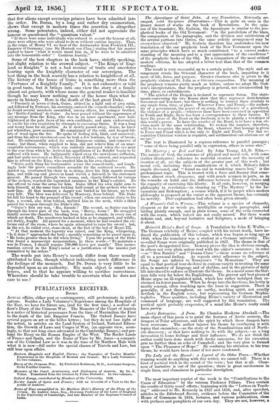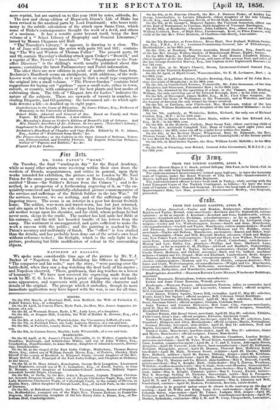PUBLICATIONS RECEIVED.
BOOKS.
Ac-rer.u. affairs, either past or contemporary, still predominate in publi- cations. Besides a Lady Volunteer's Experience among the Hospitals of the East, we have for future use, (and for the first time,) a medical of- ricer's Diary of the Crimean War. The Memoirs of the Court of Austria is a notice of historical personages from the time of Maximilian the First to the death of the late Emperor Francis. The Oxford Essays have several papers on art or the belles lettres ; but they do not lose sight of the actual, in articles on the Land System of Ireland, National Educa- tion, the Growth of Laws and Usages of War, (an opposite view, seem- ingly, to that not long since advocated in the Cambridge Essays,) and per- haps the Essay on the Roman Empire of the West. The Border Lands of France and Spain, and the Ruins of Time by Mr. Amos—a compari- son of the Criminal Law as it was in the time of Sir Matthew Hale with what it is now—fall under the special classes of Travels and Law, but still bear upon affairs.
Eastern Hospitals and English Nurses : the Narrative of Twelve Months' Experience in the Hospitals of Koulali and Scutari. By a Lady Volunteer. In two volumes.
Diary of the Crimean War. By Frederick Robinson, M.D., Assistant-Surgeon, Scots Fusilier Guards.
Memoirs of the Court. Aristocracy, and Diplomacy of Aturtria. By Dr. E. Vehse. Translated from the German by Franz Demmler. In two volumes.
Oxford .Essays, contributed by Members of the University. 1856.
Border Lands of Spain and France ; with an Account of a Visit to the Re- public of Andorre.
...Ruins of Time exemplified in Sir Matthew Hale's History of the Fleas of the Croton. By Andrew Amos, Esq., Downing Professor of the Laws of England in the University of Cambridge, and late Member of the Supreme'Council of
The Apocalypse of Saint John. A new Translation, Metrically ar- ranged, with Scripture Illustrations.—This is suite an oasis in the dreary desert of works on the book of Revelations. in the opin- ion of the translator, Mr. Godwin, the Apocalypse is similar to the pro- phetical books of the Old Testament : "in the parallelism of the lines, the composition of the paragraphs, and the division and subdivision of the several portions into threes, the same orderly arrangement may be everywhere observed." Mr. Godwin therefore has undertaken his new translation of the one prophetic book of the New Testament upon the same principles which have so much contributed "to a correct under- standing of the meaning and to a just appreciation of the excellence" of the prophetic books of the Old. By a comparison of the most critical modern editions, he has adopted a better text than that of the common readings. The result is very successful up to a certain point. The style and ars rangement retain the Oriental character of the book, imparting to it more of life, force, and purpose. Greater clearness also is given to the prophetic visions of St. John as a literary composition. The meaning of the prophecy remains pretty much as before, unless we adopt Mr. God- win's interpretation that the prophecy is general, not circumscribed by time, place, or embodiments. "The symbol of the Dragon is declared to represent Satan. The state- ments concerning the two Beasts show that they represent Antichristian Governors and Teachers ; but there is nothing to restrict these symbols to any single form, time, or place. Wherever I ono and Fraud,—the author- ity of a government, the power of an army, the influence of a priesthood, the violence of a people,—wherever these have been exercised in opposition to Truth and Right, there has been a correspondence to these figures. To have the name of the Beast on the forehead, is to be plainly a worshiper of this world's power. To have the number of the Beast, is to have a less ob- vious mark of the same relationship. To reckon the number, therefore, will be to recognize the mark of the Beast, wherever that homage is given to Force and Fraud which is due only to Right and Truth. For this re- cognition Christian wisdom is required, and arithmetical calculations are of no use."
The text is illustrated by a copious reference to parallel passages ; "some of these being parallel only in expression, others in sense also.
The Mystery; or Evil and God. By John Young, LL.D. Edin.— The nature of God, the existence of physical and moral evil, with some (rather illustrative) reference to material creation and the necessity of creation at all, are the subjects of the greater part of this work; - but moral evil, including those ramifications of it which Milton's fallen angels discussed, and "found no end in wandering mazes lost," is the predominant topic. This is treated with a force and fluency that some- times almost reach eloquence, and with much acumen in parts, as in the remarks on habit and the difference between liberty of choice mut the capacity of exercising this liberty. It all ends, however, in merging philosophy in revelation—in clearing up "The Mystery" by the In- carnation and Redemption ; a course which, if it be proper when modern philosophy is proposed at the outset as the apparent theme has certainly no novelty. That explanation had often been given already.
A Woman's Call to Women.—This volume is a species of rhapsody, eloquent so far as words go, intelligible as regards paragraphs, and hitting plainly enough, and in plain terms, some of the evils connected with the sexes, which indeed are not easily missed.' But there wants definite end, and, beyond hortative and Scripture, a mode of bringing it about.
Heinrich Heine's Book of Songs. A Translation by John E. Wallis.— The German celebrity of Heine, coupled with his recent death, have in- duced the publication of this volume, which was begun so long ago as 1840, when the translator was a student at a German university. The so-called Songs were originally published in 1827. The theme is that of the poet's disappointed love. In many pieces the idea is obvious enough, in others not very plain unless read with the editor's assurance ; in some —as "Don Ramiro" and "Donna Clara"—there seems no reference at all to a personal feeling. As regards strict adherence to the subject, the Songs are inferior to Tennyson's "In Memoriam." They are equal to that poetical tour-de-force in copious variety in treating the same idea, in mastery of language and of rhythm, and in the pictures of daily life introduced to enforce or illustrate the theme. In a moral sense the Ger- man falls very far below the Englishman. The gravest and best pieces of Heine argue an ill-regulated mind, which has rather indulged than re- strained its lower passions. When he drops into the facetious, his levity is mostly sensual, often touching upon the loose in suggestion. There is generally, if not throughout, an earthy, mocking spirit, not exactly devilish in the English sense, but representing the German Mephit- topheles. These qualities, including Heine's variety of illustration and command of language, are well suggested by this translation. The poetical spirit probably evaporates, if a mind like Heine's really could have poetry.
Arctic Enterprise. A Poem. By Chandos Hoskyns Abrahall.—The main object of this poem is to paint the features of Arctic scenery, the dangers of Polar adventure, and the spirit by which those dangers have been overcome. The author injures his theme by overlaying it with topics that encumber,--as the story of the Scandinavians 'nu' of North- ern discovery ; or that have nothing to do with the subject,—as a long invocation to home feelings and their influence. We do not think the author could have done much with Arctic enterprise, for his execution gets no further than an echo of Campbell; and the very plan is fanned upon "The Pleasures of Hope." By confining his attention to his true theme, he would have been closer if not more condensed.
The lag and the Hound : a Legend of the Olden Times—Whether training would do anything with this writer, we cannot tell. There is a kind of poetical trick in the sound of the verse ; but that is all. Clear- ness of narrative is out of the question ; there is great carelessness in single lines, and clumsiness in particular description.
The most important reprint of the week is the "Contributions to the Cause of Education" by the veteran Professor Pillans. They contain the results of thirty years' efforts ; beginning with the "Letters on Teach- ing" addressed to Mr. Kennedy in 1827 and 1828, and, after speeches, articles in the Edinburgh Review, evidence before the Committee of the House .of Commons in 1834„ lectures, and various publications, close with prefaces and pamphlets of our own day. They are not, however, a mere reprint, but are carried on to this year 1856 by notes, addenda, &c.
The new and cheap edition of Hepworth Dixon's Life of Blake has been revised in the nautical parts by Lord Dundonald; who bears testi- mony to the erubtlle calculation of the attack upon Santa Cruz, which some of Blake's contemporaries thought the work of a devil, and others of a madman. It has a notable point beyond itself, being the first volume of a " Select Library of Biography and General Literature," issued by Messrs. Chapman and Hall.
"The Traveller's Library," it appears, is drawing to a close. The 1st of June will terminate the series with parts 101 and 102; contain- ing "The Wit and Wisdom of Thomas Fuller." The present parts, 98 and 99, contain Macaulay's slashing attack upon Croker's "Boswell," and a reprint of Mrs. Piozzi's "Anecdotes." The "Supplement to the Post- office Directory" is the shilling's worth usually published about this season ; contqining the latest Parliamentary and Postal information. '
The other three are new editions in point of matter rather than form. Bechstein's Handbook seems an abridgment, with additions, of the well- known work on singing-birds; or it may be that a small type compresses the original into a small volume. "The Flower-Garden" contains brief suggestions for laying out " gardens " upon a small scale, either in town, suburb, or country, with catalogues of the best plants and best modes of cultivating them. The title of "Elegant Arts for Ladies" indicates the nature of the subjects. These are upwards of twenty in number, in- cluding Etiquette, and Oil-painting : the last-named art-to which apti- tude devotes a life-is doubled up in eight pages.
Contributions to the Cause of Education. By James Pillans, Esq., Professor of Humanity in the University of Edinburgh.
Robert Blake, Admiral and General at Sea. Based on Family and State Papers. By Hepworth Dixon. A new edition.
Mr. Macaulay's Essay on Croke'', Edition of Boswell's Life of Johnson. And Hrs. Piozzi's Anecdotes of Dr. Johnson. In two parts. (Traveller's Library.) Supplement to the Post-office London Iiirectory for 1856.
Bechstein's Handbook of Chamber and Cage Birds. Edited by H. G. Adams, Esq., Author of 'S Feathered Song-Birds," Ike.
The Plower-Garden; or the Culture in the Open Ground of Bulbous, Tuber- ous, Fibrous-rooted, and Scrubby Flowers. By Eugene Sebastian Delamer, Author of" Pigeons and Rabbits," &c. &c.
.Elegant Arts for Ladies.



























 Previous page
Previous page